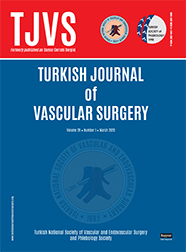
The Turkish Journal of Vascular Surgery
Yazarlar: Ali İhsan Hasde, Çağdaş Baran, Evren Özçınar, Haluk Çağlar Karakaya, Ahmet Onat Bermede, Mustafa Serkan Durdu, Levent Yazıcıoğlu, Bülent Kaya
Konular:-
Anahtar Kelimeler:Carotid endarterectomy,General anesthesia,Regional anesthesia
Özet: Objectives: The aim of this study was to evaluate the impact of anesthesia techniques on perioperative outcomes in patients undergoing carotid endarterectomy. Patients and methods: This retrospective study included a total of 264 patients (164 males, 100 females; mean age 67.2 years; range, 58 to 84 years) who underwent carotid endarterectomy in our clinic between April 2016 and October 2019. The patients were divided into two groups according to the type of anesthesia as those undergoing regional anesthesia (RA group, n=128) and those undergoing general anesthesia (GA group, n=136). Pre-, intra-, and postoperative data of the patients were evaluated. Results: The incidence of myocardial infarction and cerebral complications was similar between the groups (1.6% in RA group vs. 1.5% in GA group, p=1.00; 2.3% in RA group vs. 2.2% in GA group, p=1.00, respectively). The mean total operating time was significantly shorter in the RA group (92.5±7.7 min vs. 97.1±7.2 min, respectively; p<0.0001). The mean time to first postoperative analgesia requirement was significantly shorter in the GA group (193.9±20.8 min vs. 114.5±17.1 min, respectively; p<0.0001). The intraoperative hypotension rates were higher in the GA group (13.3% vs. 31.6%, respectively; p=0.0004), while the intraoperative hypertension rates were higher in the RA group (41.4% vs. 26.5%, p=0.0132). Postoperative hypotension (1.6% vs. 8.1%, respectively; p=0.0201), hypertension (26.6% vs. 69.1%, respectively; p<0.0001), and coexistence of hypotension and hypertension rates (2.3% vs. 9.6%, respectively; p=0.0185) were higher in the GA group compared to the RA group. Conclusion: Our study results demonstrate that anesthesia techniques do not substantially affect cerebral complications, postoperative myocardial infarction, and mortality in carotid surgery. Furthermore, RA provides better hemodynamic stability, less pulmonary complications, less analgesic use, and shorter length of hospital stay.